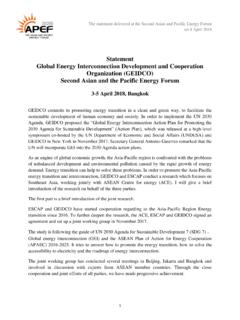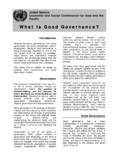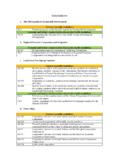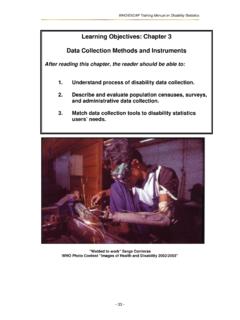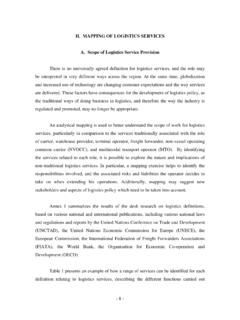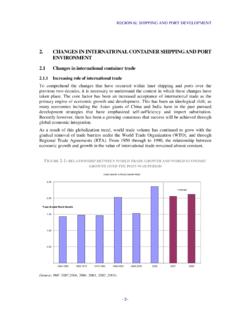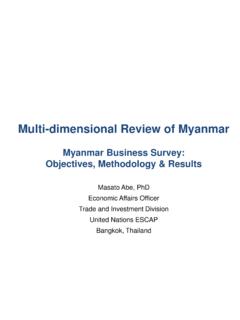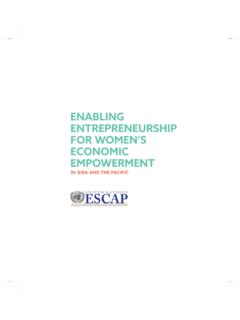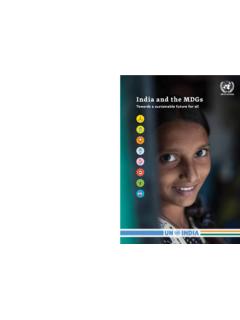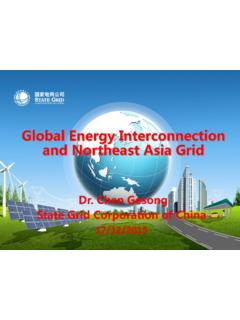Transcription of Asia and the Pacific SDG Progress Report 2019 - unescap.org
1 asia AND THE Pacific . SDG Progress Report . 2019. The shaded areas of the map indicate ESCAP members and associate members.*. The Economic and Social Commission for asia and the Pacific (ESCAP) serves as the United Nations'. regional hub promoting cooperation among countries to achieve inclusive and sustainable development. The largest regional intergovernmental platform with 53 Member States and 9 Associate Members, ESCAP has emerged as a strong regional think-tank offering countries sound analytical products that shed insight into the evolving economic, social and environmental dynamics of the region.
2 The Commission's strategic focus is to deliver on the 2030 Agenda for Sustainable Development, which it does by reinforcing and deepening regional cooperation and integration to advance connectivity, financial cooperation and market integration. ESCAP's research and analysis coupled with its policy advisory services, capacity building and technical assistance to governments aims to support countries'. sustainable and inclusive development ambitions. *The designations employed and the presentation of material on this map do not imply the expression of any opinion whatsoever on the part of the Secretariat of the United Nations concerning the legal status of any country, territory, city or area or of its authorities, or concerning the delimitation of its frontiers or boundaries.
3 asia and the Pacific SDG Progress Report 2019. United Nations Publication This publication may be reproduced, in whole or in part, for educational or non-profit purposes without special Sales no.: permission from the copyright holder, provided that the Copyright 2019 United Nations source is acknowledged. The ESCAP Publications Office All rights reserved would appreciate receiving a copy of any publication that Printed in Bangkok uses this publication as a source. ISBN: 978-92-1-120790-3 No use may be made of this publication for resale or eISBN: 978-92-1-004173-7 any other commercial purpose whatsoever without ST/ESCAP/2860 prior permission.
4 Applications for such permission, with a statement of the purpose and extent of reproduction, should be addressed to the Secretary of the Publication Board, United Nations, New York. asia AND THE Pacific . SDG Progress . Report 2019. iv FOREWORD. The asia and the Pacific Sustainable Development Goal (SDG) Progress Report 2019 assesses the region's Progress towards the SDGs and the gaps which must be closed for these to be achieved by 2030. This assessment is designed to ensure the region's actions remain on target, shortcomings are addressed as they arise, and all interested parties remain engaged.
5 The Report 's findings are a call to action. On its current trajectory, asia and the Pacific will not achieve any of the 17 SDGs by 2030. Accelerated Progress is required on all fronts. Steps have been taken towards ending poverty (Goal 1), ensuring all have access to quality education and lifelong learning (Goal 4), and to delivering affordable and clean energy (Goal 7). Yet even in these areas, success can only be achieved by 2030 if Progress is accelerated. For many more Goals Progress is stagnating. For three Goals negative trends must be reversed if we are to provide clean water and sanitation (Goal 6), ensure decent work and economic growth (Goal 8) and support of global SDG indicators.
6 With these challenges in mind, responsible consumption and production (Goal 12). I hope this Report will contribute to targeting our effort to Urgent action is needed to strengthen environmental accelerate Progress towards all Goals and to strengthen protection and combat climate change (Goal 13). The the region's commitment to improving the quality of mismanagement of natural resources explains some data and statistics essential to measuring Progress . Our of the most important gaps which need to be closed success in achieving the 2030 Agenda for Sustainable by 2030. Development depends on it.
7 There are major differences between the subregions of asia and the Pacific which have recorded different successes and face different challenges. Progress towards different Goals has been made by all subregions, but all subregions need to reverse negative trends. The lack of sufficient Progress on strengthening global partnerships and means of implementing the 2030. Dr. Armida Salsiah Alisjahbana Agenda (Goal 17) is something all subregions have in common. Progress towards this Goal is necessary Under-Secretary-General of the United Nations to ensure our region has the means to finance, target and Executive Secretary of ESCAP.
8 And implement policy solutions to achieve all Goals. Today, all of Goal 17's underlying targets need to be accelerated. Across all Goals and in all subregions, the lack of reliable data is one of asia and the Pacific 's biggest challenges. We have worked to incorporate significantly more SDG indicators than in our previous Report and to provide more disaggregated data by age, sex and location. Data gaps nonetheless remain for two thirds v asia AND THE Pacific SDG Progress Report 2019. ACKNOWLEDGEMENTS. The asia and the Pacific SDG Progress Report The team for the production of this Report includes: was prepared by the Statistics Division of the United Nations Economic and Social Commission Overall supervision and final review for asia and the Pacific (ESCAP) under the overall Gemma Van Halderen leadership and guidance of Armida Salsiah Alisjahbana, Under-Secretary-General of the United Nations and Executive Secretary of ESCAP.
9 Hongjoo Hahm, Deputy Coordinator Executive Secretary for Programmes, Economics Arman Bidarbakht Nia and Financing and Kaveh Zahedi, Deputy Executive Secretary for Sustainable Development provided Core team of authors valuable guidance and oversight. Arman Bidarbakht Nia, Eric Hermouet, Dayyan Shayani, Phuong Tran Reviewers Paul Anthony Bunsell, Vatcharin Sirimaneetham, Van Nguyen Analysis and data management Coordinators: Eric Hermouet and Dayyan Shayani Bhagya Maheshi Gangoda Gamachchige, Cathy Conzemius, Janet Irene Ying, Jiahui Li, Krisana Boonpriroje, Maria Belen Fontecilla, Marisa Limawongpranee, Ngoc Thanh Huyen Tran, Nixie Mabanag-Abarquez, Panpaka Supakalin, Shijie Luo and Tianheng Yu Layout and graphic design Darya Dickinson Administrative support Krisana Boonpriroje, Rattana Duangrapruen Photo credits Part I iStock ID 503871258, credit: pixelfusion3d.
10 Part II iStock ID 963146452, credit: Adrian Catalin Lazar;. Part III iStock ID 641340762, credit: pixelfusion3d;. Annexes iStock ID 899288896, credit: yangna vi CONTENTS. Foreword iv Acknowledgements v Abbreviations viii Executive summary ix PART I: asia - Pacific SDG Progress 1. 1. SDG Snapshot: Where did the asia - Pacific region stand for the 17 Goals in 2018? 2. 2. SDG Dashboard: Where will the asia - Pacific region be in 2030? 4. 3. Progress gaps: Needed course correction and acceleration 7. 4. Summary and conclusions 9. PART II: SUBREGIONAL INSIGHTS 11. 1. Different subregions, different challenges 12.
